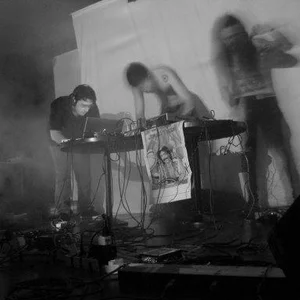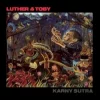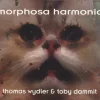Biography Toby Dammit
The true story behind Toby Dammit leaves some dizzy-headed, but the fact is this fella has worked his ding-dang butt off. Originally left on an East Tennessee doorstep to wander the wacky world of Appalachian orphanages, he found the trusting care of the most significant Tympani instructor in the American South. Tutored for ten years as a tympanist, he transformed into a symphonic terror in the Southeastern U.S.A. as a teenager. Mere sight of his arrival at regional percussion competitions left many an ambitious stick-whacker grinding their teeth on the trail back home.
However Toby’s duration in the grown-up symphonic world didn’t last. He canceled another year of stuffy attitudes and puffy conductors - turning to teenage punk rock nightlife and local bands. As the Tennessee walls closed in, he realized he’d have to leave, perhaps not to return. By 1986 he’d fled to California to live and work with Greg Ginn, founder of Black Flag and SST Records. His trail led him into the notorious cow-punk band Tex and The Horseheads for a year. He then fatefully met organist Luther Hawkins and together they performed with Paul Roessler of The Screamers. During this period he also made an album with producer Lou Adler (producer of “The Rocky Horror Picture Show”, Mamas and Papas, and Cheech and Chong). But his life changed dramatically at the age of 22 when Iggy Pop claimed him for his own in 1990.
Iggy showed Mr. Dammit the real ups and downs in the world of show business, as they toured incessantly and recorded several albums for Virgin Records from 1990 to 1999. Despite seemingly endless international tours and the thousand familiar blurred faces in so many troubled places, life on the road proved Toby a survivor. Gradually, that buried symphonic percussionist raised a muffled head, as Toby increasingly worked in film productions. In 1997 Johnny Depp invited Toby to accompany him up the red carpet at Cannes Film Festival for the premier of his first written and directed feature film “The Brave,” which Toby had painstakingly worked on with both Depp and Iggy.
In 1995 Dammit joined the New York band SWANS, relocating from San Francisco to New York soon after. SWANS founder Michael Gira wanted Toby to bring them into a symphonic bombassite’ onstage. That year SWANS toured worldwide with Toby simultaneously pounding a giant bass drum with his right arm, while delicately playing a vibraphone with two mallets in his left hand, standing with a strapped on marching snare drum and stomping a bass drum with his foot! Audiences were not prepared for the cacophony capable from this one man, not to mention the outrageous visual spectacle! Toby continued work with Gira on 7 albums, even as Gira transformed the group into Angels Of Light. Toby pushed his dextrousity even further with AOL, simultaneously playing an organ and drumset onstage! Working with Gira taught Dammit many things, but perhaps most interesting was working closely with an artist who owned their own record company. On one hand it took enormous effort learning to survive, constantly self-financing projects year after year, but on the other hand it allowed tremendous freedom to do what you want, outside of THE GRID.
New York City offered a full spectrum of artists and projects for Dammit. He worked on productions that ranged from playing all the punk rock drums on the film score for “School Of Rock” to pounding on air vent sheet-metal tubing for Ryan Adams. As word got around of his symphonic instrument collection, he harnessed a mind-boggling schedule of productions as a sought-after percussionist. Ely Guerra arrived from Mexico City ready to make her 2nd album for EMI. “Lotofire” was the first album where Toby could freely explore complex layering of exotic percussion and old school jazz drumming with oddly manipulated drum machines. “Lotofire” was unlike anything ever released in Mexico and years later would be released in the States as a modern piece of work ahead of it’s time.
While constantly working in France with Iggy, he befriended French producer Bertrand Burgalat, who began inviting him to Paris for his productions. Burgalat was also an artist who owned his own record company Tricatel. Soon came an invitation to record a solo album at Tricatel studios in Paris and the official crowning of his name, both which Bertrand owned! Burgalat opened the flood gates for experimentation with few requests. He wanted no lyrics – only percussion and atmospheres. Toby was given the studio and let loose. Working with engineer Peter von Poehl (freshly immigrated from Malmö, Sweden) the two set up a wall built of every amplifier they could find...some 15 stacked strong! They proceeded to run manipulated drum machines, tympani, marimba, vibraphone, drumsets, you name it, through the wall of amps simultaneously. It sounded like unbridled electricity, kind of a loud melodic rock band, but without the tonality of string or voice – bizarre, alien and funky. Burgalat wanted a psychedelic percussion-only album with heavy beats and he got it. New York record store Other Music released the “Top Dollar” sessions on their label Omplatten in 1999. “Top Dollar” also prompted Toby to consider this as an opportunity to start his own label.
For many years at this stage Toby had been rumored to be involved in some manner with the most legendary band of mystery The Residents. While their management Cryptic Corporation and their label Ralph Records both acknowledge his frequent appearance on their records and possibly even onstage, it remains foggy as to “what it is” he may or may not have done, much less how or where. Cryptic were quoted in the liner notes of “Top Dollar” as being highly fond of Monsignor Dammit’s work, as was Mark Mothersbaugh, who coined the phrase “The asses are masses who need to wear Dammit glasses!” Nonetheless there is a genuine common thread; The Residents have always survived as an independent organization running their own record company since their beginning some 35+ years ago.
In 2000 Toby partnered a record label in Hamburg, Germany called Hit Thing (English/German reversed translation game of “drummer”) with Guido Randzio, (who partnered the EuroRalph label with The Residents). Call it a coincidence or what have you, but they do share the same office and staff. It is possible that at a relatively young age Dammit realized from working with several artists running their own label and business that this was the only way to survive happily in the long run. The modus operandi for Hit Thing would be to construct an odd repertoire, combining renegade lost re-issues and new productions of Toby’s. Notably their first re-issue, Georges Montalba's “Hi-Fi Fantasy in Pipe Organ and Percussion”, exposed Anton LaVey’s (founder of the Church of Satan) claim to be Montalba as phony-baloney and revealed the true organist, Robert Hunter, solving a heated 45 year mystery with an extensively researched life story of Mr. Hunter, sadly confirmed and dictated to Toby from Robert's death bed. Inspired by Hunter's tremendous musical life and talent, Dammit reunited with lifelong friend and organist Luther Hawkins in Los Angeles to record together in 2000. Working alone in Luther’s house with Grammy Award winning producer Mark Howard (Lucinda Williams, Tom Waits, Daniel Lanois, Emmylou Harris), they created a lovely instrumental album called “Karny Sutra”. Luther & Toby took Montalba's exotic atmospheres into a modern explorative realm with darker electronic textures, all the while respecting a stately tradition of mystery and romanticism using organ, piano and percussion.
In 2001 Toby met director Mark Whiting while performing at UCLA's Royce Hall. Whiting had been referred to Dammit to score his first film, entitled “Apple Jack”. Neither of the two realized the depth of what they were getting into, but this meeting was the beginning of a 4 year production. Whiting contracted Toby to score his masterpiece “Apple Jack” and he had BIG expectations. He wanted a full 1940's Hollywood soundstage orchestral score combined with a bluegrass band, as well as hair raising science fiction electronic atmospheres. Toby took it on and spent the rest of his New York years perfecting the score with a 21-piece hand picked orchestra. The official release of “Apple Jack” would not occur until 2006, nonetheless the combined maniacal efforts of Whiting and Dammit continue to blow people's minds today.
In 2002 a friend from Paris called Toby up and asked if he would be interested in accompanying American writer Bruce Benderson for a live performance in Paris. Benderson lived in New York, so it was easy to rendezvous and put it together. The pair hit it off and took thier show to La Cigale in the Pigalle district of Paris for all to see. No one there realized that Bruce was reading excerpts from the next book that would take France by storm, “The Romanian”. Toby composed a Romamian influenced electronic score that he performed live with a Buchla Marimba Lumina synthesizer played through a wall of heavy amplification. As Toby performed in his colorful cowboy attire and Benderson read pages upon pages of the most detailed descriptions of fellatio possibly ever uttered from man, the audience was awash with awe. Benderson finished his story of obsession while slamming a giant circus bass drum throughout the final climax. “The Romanian” / “Autobiographie Erotique” won the Prix de Flore upon it's release, a prize heretofore only given to French authors. Benderson was in fact the first American in history to take France's highest literary prize.
Later that year Bertrand Burgalat came to New York City to perform with Toby. Toby surprised his French producer, as he performed an all-percussion tribute to Tricatel’s roster of singers with an all-girl percussion section! Burgalat soon invited Dammit to become musical director of his prized Tricatel chanteuse April March. Toby redesigned Bertrand’s complex studio productions for stage and together they toured Canada, America, Switzerland and France. Toby then joined Bertrand for solo performances across Russia in 2003, as they prepared material for a new Burgalat solo album hoped to be recorded in Berlin.
Hence Berlin became Toby's new destination for inspiration. In 2003 he came to Berlin to record the duet album “Morphosa Harmonia” with another lifelong friend; Bad Seeds drummer, Thomas Wydler. In those pleasurable sessions he met engineer Ingo Krauss, of Conny Plank Studios. “Morphosa Harmonia” provided an artistic breakthrough for Toby. He layered abstract phonetic choral arrangements using his own voice, giving each piece a uniquely exotic pan-Pacific choir, seemingly either male or female, both young and old to Wydler's high tempered percussive grooves and atmospheric bebop influenced environments. The results are, well...not like anything anyone had imagined before and absolutely beautiful. Now Toby realized Berlin was the right place to go.
In 2004 Dammit brought the New York band Bee and Flower to Berlin to produce their second album “Last Sight Of Land”, working with Krauss. “Last Sight Of Land” unfurled Toby's orchestral arrangement abilities to the max. Bee and Flower’s writer Dana Schechter wanted an orchestral album. New York's cost of living made such dreams impossible, but Toby knew it was possible in Berlin. Gathering a large ensemble of Berlin's young string players, the album is layered with full choir, string section, bass section, percussion section and electronics, all arranged by Dammit. Bee and Flower permanently relocated to Berlin during the production and Toby chose to stay there as well. The trans-Atlantic move was not lite-weight, but it resulted in a productive explosion for Dammit. Working out of the former DDR radio and television broadcasting center in East Berlin, Toby found the perfect environment for any sort of production he could imagine small or gargantuan.
In 2005 Burgalat arrived and they made the extraordinary album “Portrait-Robot” there. Toby found himself again in a ground breaking production. “Portrait-Robot” defied all traditions of French record production, though Burgalat is known for such radical directions. “Portrait-Robot” was literally a personal psychological examination of Burgalat song after song questioning and reflecting his every thought and feeling (euphoric to horrible) sometimes disguised with dance music and other times floating amid subsonic urban atmospheres, always unlike any other previous attempt by a French artist. Toby’s label Hit Thing licensed “Portrait-Robot” outside of France - an interesting combination of artists working together to survive outside the constraints of the giant corporate titans.
In 2006 another contemporary genius landed in Berlin and looked Toby up. Rufus Wainright had arrived to record his album “Release The Stars” and he wanted Toby to bring “everything he had” into the DDR studio. Much to Toby's surprise he actually did unpack nearly every instrument in his collection. “We even went outside in the forest looking for tree limbs to step on to simulate a person's back being broken!” The two North American exiles found much in common being so far from home and alienated by the war. Rufus was working with Neil Tennant as producer and the sessions were filled with much inspiration and exploration by all involved.
Today Toby has joined (another inspired American exile exploring Berlin's possibilities) Jessie Evans and is performing across Europe and Mexico together as a duo. They're currently working on Evans' new solo album both in Berlin with Thomas Stern and in Mexico with Pepe Mogt from Nortec Collective. Jessie and Toby traveled to Mexico in August and have been recording everywhere from the barrios of Mexico City to John Wayne's house in Acapulco to the Playas of Tijuana!
One thing seems certain; the words of his hometown patron saint and inspiration Dolly Parton ring clear:
“Never underestimate the will of a bastard from Sevierville, Tennessee.”
Creative Commons By-SA License
 FM
FM



